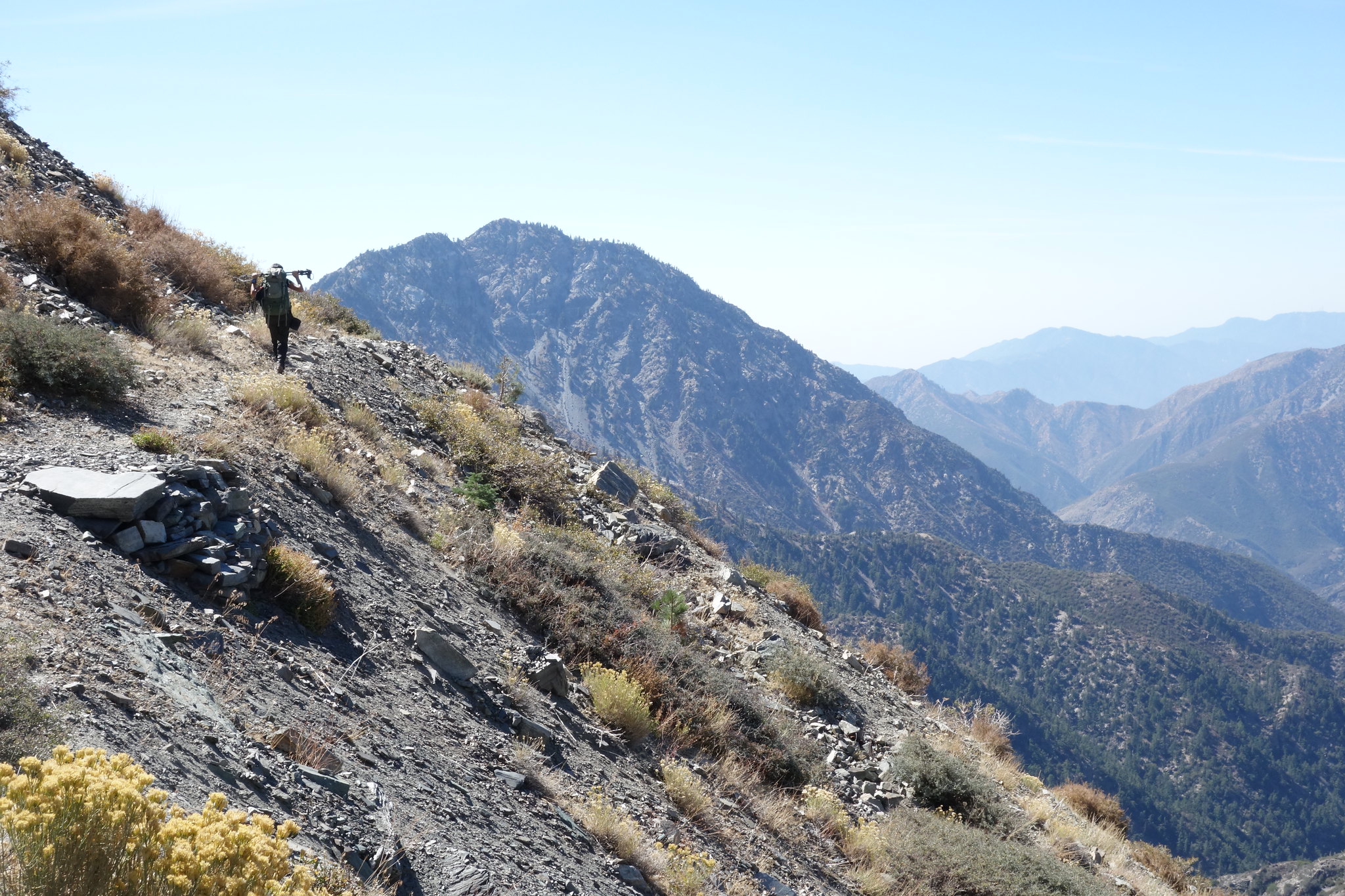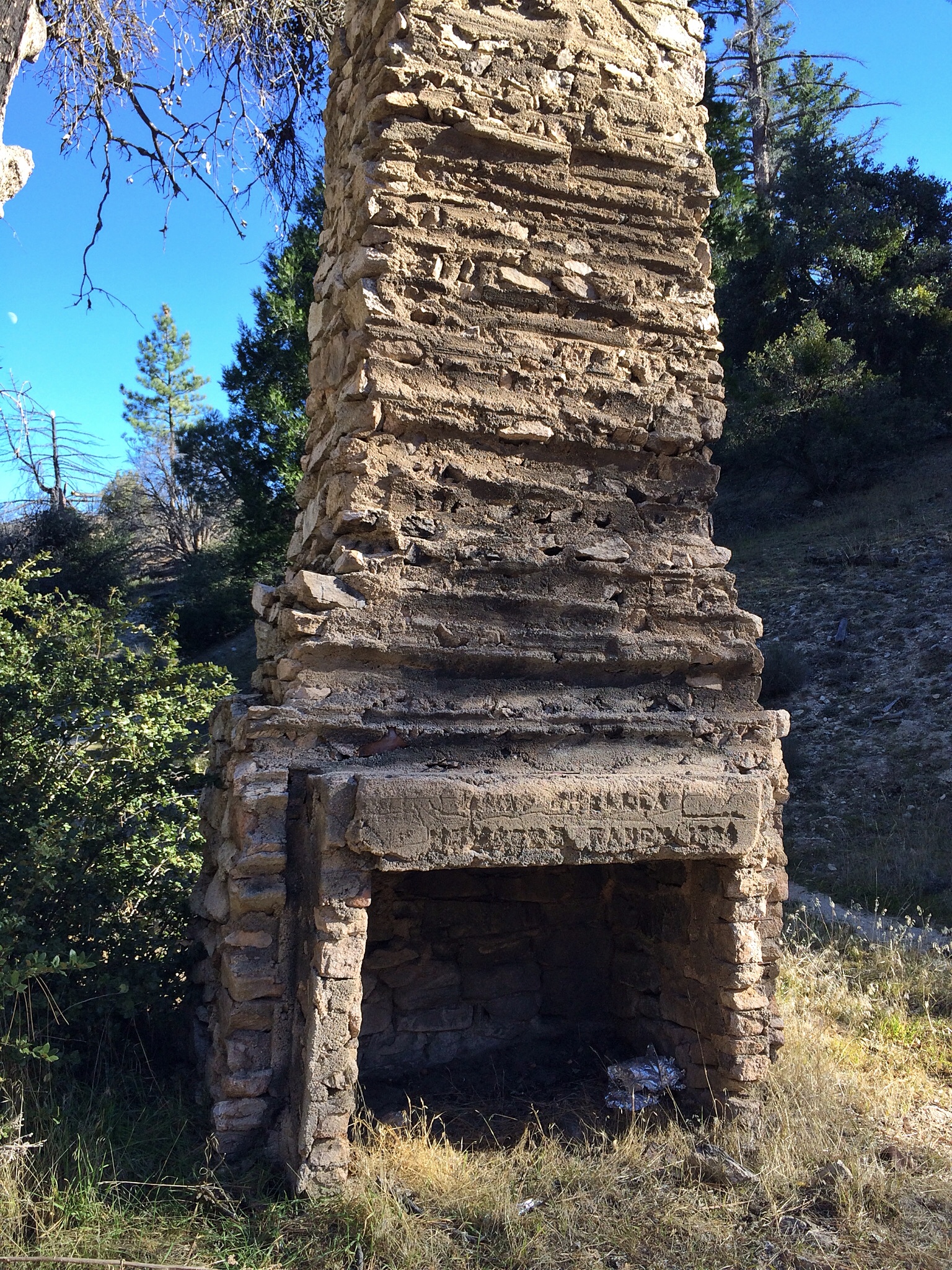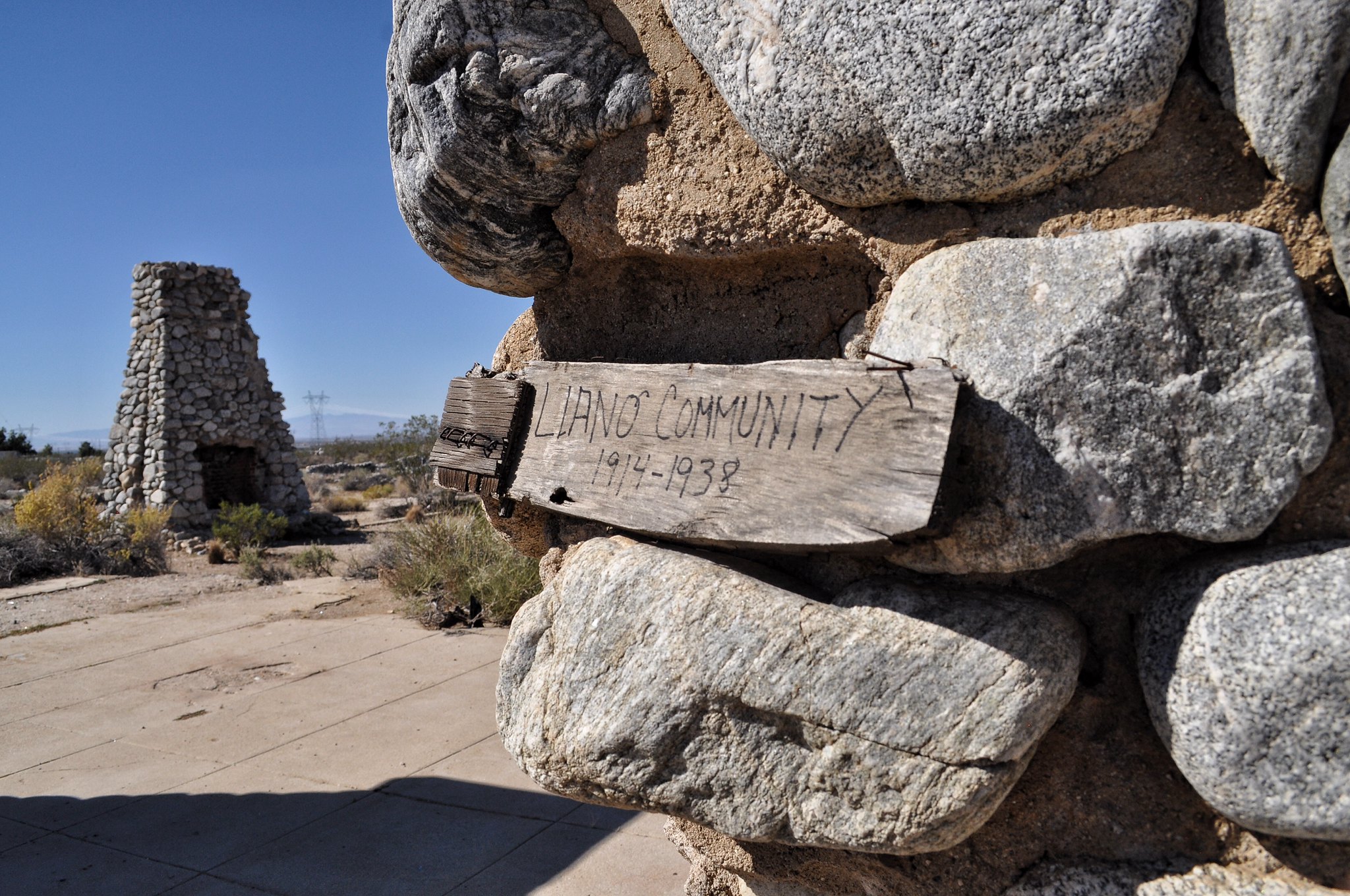Camp 37 Cedar Springs
Inmates constructed the highest tunnels in Los Angeles at an elevation of 6,800 feet, showcasing remarkable engineering along the Angeles Crest. This segment of the highway, between Cedar Springs and Islip Saddle, faced two steep ridges of Mt. Williamson that were too sheer for a road. As a result, tunnels were necessary, and most of the excavation involved blasting through solid granite. The tunnels were part of the final stretch in the completion of the Angeles Crest Highway, a project 27 years in the making, spanning from La Cañada to Big Pines.
 Overview of the Angeles Crest Highway from La Canada to Big Pines. Credit: Metro Transportation Archives
Overview of the Angeles Crest Highway from La Canada to Big Pines. Credit: Metro Transportation Archives
Camp 37
Inmates working on the final section of the Crest Highway were housed at Camp 37 in Cedar Springs, just west of the tunnels. This facility operated as a minimum-security prison honor camp. The State Department of Corrections oversaw the inmates, while employees from the Division of Highways supervised the work carried out by the inmate crews. The prisoners were housed in barracks while the supervisors, their families and civilian workers were housed separately a mile away.
 Topo Map of Waterman Mtn 1959 showing Camp 37 which occupied both Eagles Roost Day Use Area and Cedar Springs. Note the Dam/Pumphouse upper right.
Topo Map of Waterman Mtn 1959 showing Camp 37 which occupied both Eagles Roost Day Use Area and Cedar Springs. Note the Dam/Pumphouse upper right.
Camp 37 housed a school for the children of civilian employees, which became one of the last remaining one-room schoolhouses in the nation. Known as the “little red schoolhouse,” it served all elementary grades, with qualified teachers provided by the Pasadena City School District. By establishing the school within the camp, the family were spared a 74-mile round trip that would have been necessary if they had to attend school in La Cañada.
 Honor Camp 37 cottages for State Division Highway Employees. The building at left is the schoolhouse operated by the Pasadena City School District (later Camp Glenwood cabin). Credit: CA Hwys & Public Works, 1956
Honor Camp 37 cottages for State Division Highway Employees. The building at left is the schoolhouse operated by the Pasadena City School District (later Camp Glenwood cabin). Credit: CA Hwys & Public Works, 1956
 Snow conditions at Camp 37. Credit: CA Hwys & Public Works, 1956
Snow conditions at Camp 37. Credit: CA Hwys & Public Works, 1956
While working at the Angeles Crest road camp the prisoners were housed in comfortable barracks situated in beautiful surroundings. There were no armed guards or firearms in the entire camp, each prisoner being on his honor. Carefully chosen from the inmate population at the California Institution for Men in Chino, these prisoners were eager to leave confinement and work outdoors. Each inmate expected to stay for only six months to two years, as they were nearing parole. As trustees, they earned wages while in the program.
The prisoners worked alongside foremen employed by the Division of Highways, tackling a range of tasks. They blasted tunnels through the mountains, crushed rocks, built culverts, poured concrete, cleared underbrush, cut timber, and scaled steep cliffs to dislodge any loose rocks that could later fall and obstruct the highway.
In all the years of the camp’s existence, escapes were few in number. The consequence for breaking the rules at Angeles Crest was an immediate return to Chino. Inmates attempting to escape not only forfeited their parole dates but also risked an additional sentence of one year to life at San Quentin or Folsom.
Escape “opportunities existed, as there were no fences or bars, but a check was run every two hours, and the $3.30 a day, which could not be spent easily, plus living in the out-of-doors in a self-contained community, and the fact that there really wasn’t anywhere to escape to – made visitors to the work camp sometimes wonder who were the prisoners and which men were the guards.”
Although escaping from Angeles Crest was relatively easy, few men attempted it. They had too much to lose by fleeing and much to gain by staying.
The road camps were part of the rehabilitation program implemented by the State Department of Corrections, aimed at preparing men for a smoother transition back into society upon their release. Inmates in the honor camps underwent comprehensive screening before being assigned to work on the Crest. Many successfully reintegrated into society after completing their sentences, emerging as reformed individuals equipped with new skills to support themselves.
WW2/Two Tunnels Built
 Topo Map of Crystal Lake 1941 showing where the Angeles Crest Highway reached.
Topo Map of Crystal Lake 1941 showing where the Angeles Crest Highway reached.
 Tunneling construction around 1949. Credit: UCLA Archives
Tunneling construction around 1949. Credit: UCLA Archives
By 1941, construction of the Angeles Crest Highway had reached as far as Mt. Islip, but plans were abruptly altered when the United States entered World War II. The War Production Board halted work, deeming the highway a non-essential, recreational road. Construction didn’t resume until 1946, and although material shortages caused delays, efforts were made to complete the final miles.
The final section of the Angeles Crest Highway—a 16.3-mile ledge carved from steep granite mountain shoulders at elevations between 6,500 and 8,000 feet—required the construction of two tunnels to reach Islip Saddle. A pilot tunnel was excavated to accommodate equipment and crews for the second tunnel. This pilot tunnel also functioned as a ventilation system and provided valuable exploratory data before the full excavation of the main tunnel face.
Construction crews worked tirelessly, day and night, drilling and blasting through solid rock with increasing efficiency. This work was grueling and backbreaking, often dangerous, involving significant amounts of dynamite on unstable, nearly vertical slopes. The first tunnel measures 680 feet in length, while the second is 470 feet long, separated by 87 feet of open-cut roadway. Both tunnels were designed with dimensions of 32 feet wide and 21.5 feet high, and their portals are adorned with picturesque rough stone masonry.
 A drawing outlining the steps into construction of the tunnels. Credit: CA Hwy & Public Works, 1941
A drawing outlining the steps into construction of the tunnels. Credit: CA Hwy & Public Works, 1941
 At left, portal of tunnel No. 2 through ridge of Mt. Williamson. At right top, equipment mucking at main heading of tunnel No. 1, showing protective shell in use. Below, construction yard between tunnels and the building of concrete tunnel lining form. CA Hwys & Public Works, 1941
At left, portal of tunnel No. 2 through ridge of Mt. Williamson. At right top, equipment mucking at main heading of tunnel No. 1, showing protective shell in use. Below, construction yard between tunnels and the building of concrete tunnel lining form. CA Hwys & Public Works, 1941
 Arrow points to tunnel no. 1 under construction through ridge of Mt. Williamson on Angeles Crest Highway.CA Hwys & Public Works, 1941
Arrow points to tunnel no. 1 under construction through ridge of Mt. Williamson on Angeles Crest Highway.CA Hwys & Public Works, 1941
 Arrows point to 2 tunnels separated by only 87 feet of highway being bored through Mt. Williamson on Angeles Crest Highway. CA Hwys & Public Works, 1941
Arrows point to 2 tunnels separated by only 87 feet of highway being bored through Mt. Williamson on Angeles Crest Highway. CA Hwys & Public Works, 1941
Additional Work from Camp 37
Not only did inmates at Honor Camp 37 built the tunnels but they also assisted in constructing the link between the Angeles Crest Highway and the Crystal Lake recreation area (Highway 39). This highway was designed to provide a circular route from Azusa to Crystal Lake and back down to La Cañada via Angeles Crest. However, the section of Highway 39 south of Islip Saddle remained open only from the early 1960s until 1978, as it was frequently closed due to fires, mudslides, and erosion.
 View from Eagles Roost Day Use Area, showing the closed off link Highway 39 to Crystal Lake
View from Eagles Roost Day Use Area, showing the closed off link Highway 39 to Crystal Lake
Angeles Crest Highway Legacy
To construct the Angeles Crest Highway in its entirety, CCC camps were established at various points along the route between 1930 and 1933. This initiative aimed to alleviate unemployment in Los Angeles and provide a workforce for the area. Subsequently, prison labor was also employed to carry out the hazardous work.
 CCC chow line at Angeles Crest Ridge
CCC chow line at Angeles Crest Ridge
 Road construction Camp in the Angeles Forest, 1933. Sign says “LA Co Forestry Camp No. 8”. Credit: National Archives
Road construction Camp in the Angeles Forest, 1933. Sign says “LA Co Forestry Camp No. 8”. Credit: National Archives
Approved for construction in 1919, the Angeles Crest Highway was slowly built over 27 years by civilian work crews and prison laborers, culminating in the completion of the 65.36-mile modern mountain highway. By 1956, the scenic road stretching from La Cañada to Big Pines was finally finished.
 Ribbon-cutting dedication ceremonies were held on November 8, 1956. Procession on newly constructed Angeles Crest Hwy (CA-2) tunnels, Nov 1956. DOH D7 Archives photo
Ribbon-cutting dedication ceremonies were held on November 8, 1956. Procession on newly constructed Angeles Crest Hwy (CA-2) tunnels, Nov 1956. DOH D7 Archives photo
 Final 16-mile link of the Angeles Crest Highway, 1956. Credit: USC
Final 16-mile link of the Angeles Crest Highway, 1956. Credit: USC
 A driver and her car. Tunnel can be seen in the background,1956. Credit: USC
A driver and her car. Tunnel can be seen in the background,1956. Credit: USC
Vast expanses of untouched mountain terrain, once accessible only to the hardiest hikers, were now available for public recreational use. Motorists now saved considerable miles traveling from Los Angeles to Big Pines and Wrightwood, which were previously accessible only by back approaches around the San Gabriel Mountains. The completed Angeles Crest Highway significantly improved access to the summer and winter recreational areas managed by the U.S. Forest Service.
 LA residents can now enjoy a shorter ride to Big Pines, Wrightwood. Claremont Colleges Photo Archive
LA residents can now enjoy a shorter ride to Big Pines, Wrightwood. Claremont Colleges Photo Archive
The entire length of the highway, meandering through the heart of the 700,000-acre Angeles National Forest, offers motorists a breathtaking drive through nature’s wonderland. The backcountry winds through stunning, jagged high-altitude high-altitude terrain, providing panoramic views of the city to the south and desert valleys to the north. Along the final completed section of the highway, impressive granite pinnacles, such as the castle-like Mt. Williamson, rise dramatically at 8,214 feet. After climbing to the 8,000-foot Dawson Saddle, the road descends to Vincent Gap at 6,585 feet before ascending once more to the 7,380-foot Blue Ridge.
 Motorists could now access sites like Inspiration Point near Blue Ridge. Photo here was taken in 1925. Credit: LAPL
Motorists could now access sites like Inspiration Point near Blue Ridge. Photo here was taken in 1925. Credit: LAPL
 The Mt. Williamson tunnels today, adorned with picturesque rough stone masonry. Photo by David Gordon
The Mt. Williamson tunnels today, adorned with picturesque rough stone masonry. Photo by David Gordon
 View of Bear Creek from the tunnel site
View of Bear Creek from the tunnel site
 View of Craggy Mt. Williamson and tunnel
View of Craggy Mt. Williamson and tunnel
Present Site
Camp 37 was razed to make way for Eagles Roost Picnic Area (The Eagles Roost name was in use by 1970s, the name referring to the Williamson Rock). Camp 37 occupied both present Eagles Roost Picnic Area and Cedar Springs.
 Eagles Roost Day Use Area today
Eagles Roost Day Use Area today
 View of the Williamson Rock, formerly popular with rock climbers
View of the Williamson Rock, formerly popular with rock climbers
Mile marker 61.09: Cedar Springs Camp 37 administrative site once stood here, providing housing quarters and offices for the civilian employees. The abandoned schoolhouse was moved three miles west to an old logging road and transformed into Camp Glenwood, a youth camp dedicated to immersing participants in the wilderness while emphasizing outdoor education and conservation.
 The “little red schoolhouse” of Camp 37 was relocated a few miles down the road and is now Camp Glenwood. It sits right along the PCT
The “little red schoolhouse” of Camp 37 was relocated a few miles down the road and is now Camp Glenwood. It sits right along the PCT
Mile marker 61.65: Eagle’s Roost Picnic Area- Camp 37 prisoners barracks site
 The Camp was razed and made into a picnic site as seen here
The Camp was razed and made into a picnic site as seen here
 A few random stone masonry relicts exist, perhaps clues to the former buildings
A few random stone masonry relicts exist, perhaps clues to the former buildings
 Marker at Eagles Roost showing date of 1967, likely when Camp 37 was completely razed
Marker at Eagles Roost showing date of 1967, likely when Camp 37 was completely razed
 Found along the camp site: A prohibition era bottle thats says “FEDERAL LAW FORBIDS SALE OR REUSE OF THIS BOTTLE”
Found along the camp site: A prohibition era bottle thats says “FEDERAL LAW FORBIDS SALE OR REUSE OF THIS BOTTLE”
Mile marker 61.80: CALTRANS sand shed and site of the former saw mill for Camp 37. All timber required for tunnel construction was sourced from along the highway and cut at this local mill
 The former saw mill with a huge circular saw. Honor prisoners saw logs here during the winter when road construction is halted by snow. Timber was cut from trees felled along Angeles Crest Highway for use.
The former saw mill with a huge circular saw. Honor prisoners saw logs here during the winter when road construction is halted by snow. Timber was cut from trees felled along Angeles Crest Highway for use.
Mile Marker 62.45: The Camp 37 pump house was situated at the base of the canyon, where two drainages converge. There used to bean old building with a metal roof with an old wooden flume. At the cabin site there was a dam and catch basin. From this point camp 37 siphoned water up the hill to their inmate outpost.
Mile Markers 62.85- 63.05: The two tunnels run at Mount Williamson-named after Lieutenant Robert Stockton Williamson (1824-1882), U.S. Army topographical engineer, who made a reconnaissance of the north side of the San Gabriel Mountains for the Pacific Railroad Survey in 1853
 Me sitting at the tunnels ledge. Photo by David Gordon
Me sitting at the tunnels ledge. Photo by David Gordon
Resources
Metro Archives
PBS SoCal
PBS Socal
Angeles Crest Highway Road Guide







